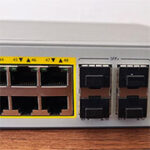The FS S3400-48T4SP is a 48-port PoE+ L2 managed switch that the manufacturer has made available a couple of years ago and yes, there is a newer version called the S3410-48TS-P which does come with some improvements, such as bigger PoE budget or hot-swappable power supplies.
| FS S3400-48T4SP | |
|---|---|
| FS.COM | Check Product |
But the price tag is also significantly higher, so, if you don’t truly need these features, then the FS S3400-48T4SP remains a solid option for a larger network. The 48 ports do show the affinity for a large number of networking devices, but, since the PoE budget is 370W, I suppose it could accommodate only a bit more than ten PoE access points (the higher end models).
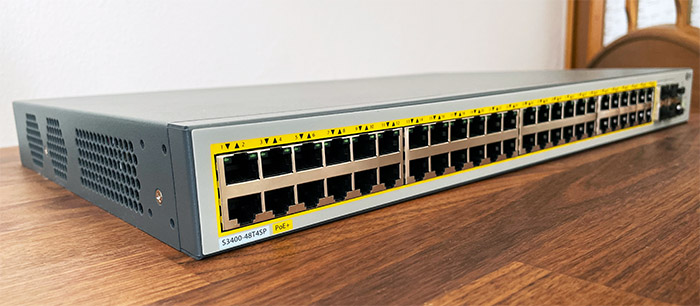
There are also four 10Gb uplink SFP slots which allow long-distance communication between networks using fiber optic modules and cables. FS actually offers some reliable, yet affordable fiber optics cables and modules, and this approach is also true for their switches as well because after testing a lot of FS devices, it’s clear that the hardware is top-notch, while the software does closely resemble what Cisco has to offer.
Before checking out the FS S3400-48T4SP and put it to the test, I also need to mention that the Ethernet switch cannot be stacked, which is a bit of a shame considering that so many other models do support this useful feature. If it’s mandatory for your network set-up, then you can check out the newer FS S3410-48TS-P.
Design and Build Quality
The FS S3400-48T4SP is a 48-port switch, so the front side is filled with Ethernet ports and as expected, this is a large device, just enough to fit into a rack (U1). Indeed, the rectangular case measures 17.37 x 11.04 x 1.75 inches (44.1 x 28.0 x 4.4 cm) and FS didn’t cut any corners from the build quality, making the Ethernet switch fully metallic. A 48-port Ethernet switch is going to get hotter much easier, especially if all ports are being used, including reaching the maximum PoE budget.
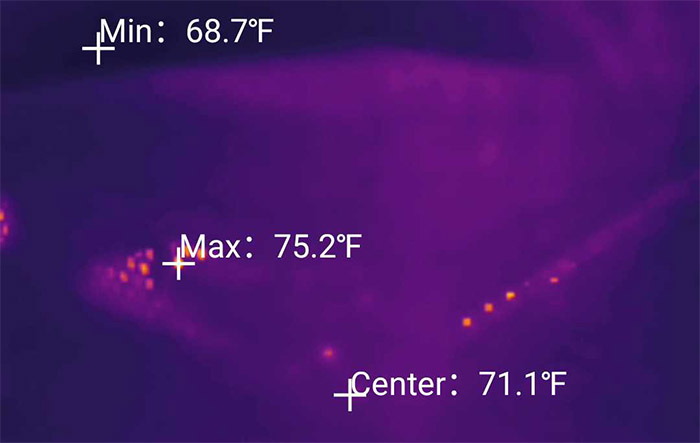
But the manufacturer has added three fans on the right side for the air intake, while on the left side, there is a single fan to help push out the hot air + there are several other ventilation holes. This includes an additional fan hole, but FS didn’t consider that the FS S3400-48T4SP needed more help at keeping the hardware cool enough. I haven’t really been able to push this Ethernet switch to the maximum, but I still connected 13 PoE access points and the metallic case does get warm, but the fans are efficient enough as to not let the heat linger long enough as to overheat the device.
But are the fans loud? Well, they’re not silent at all and there are four of them, so you’ll definitely hear the fans when they’re operating – then again, when the device is in a rack, the noise shouldn’t bother anyone. On the left and right side of the FS S3400-48T4SP, there are mounting holes for the rack brackets (they’re there, in the package), but, if you hoped to put this large and heavy switch on the wall (it weighs 9.48 lbs), there are no bottom-placed mounting holes, so you can’t do that.
The good news is that you do get some silicone feet in case you like to lose a lot of space from your desk. On the rear side of the Ethernet switch, you can find the usual Power port alongside a large and easy-to-press Power switch.
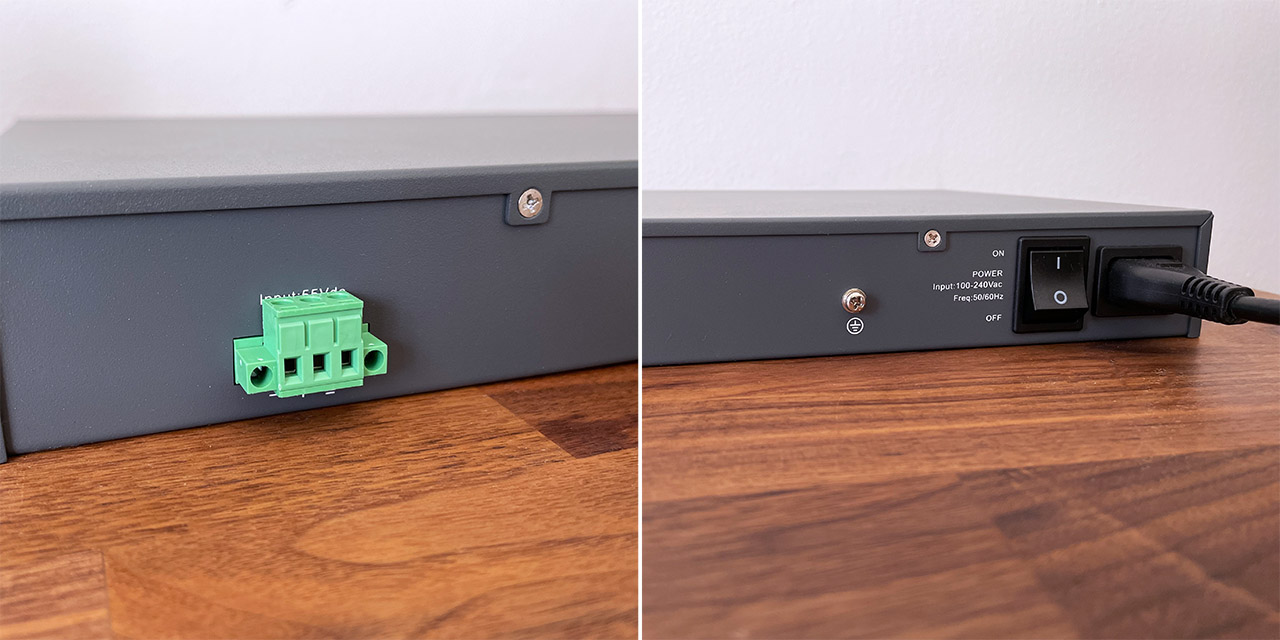
And there is also a grounding screw, as well as a weird looking connector. That’s actually the DC power supply, so FS did take into account the users that prefer a more efficient way to power up the FS S3400-48T4SP (this also means support for hot restart). You still get a regular PSU as well and it’s internal, so no power brick hanging out.
Going to the front of the network switch, there are actually less LEDs than on other switches and that’s because of the 48 Ethernet ports. Of course, each has its own LED indicating that there is data transfer happening on that specific Ethernet port. All the ports are PoE+ (there’s support for IEEE 802.3af/at standards) and, as I mentioned before, the maximum budget is 370W, so you won’t be able to use 48 PoE wireless access points (unless they’re unnaturally power efficient).
There is an LED on the right side to let you know when you reach the maximum budget, alongside a SYS and PWR LED. Next to the 48 Gigabit Ethernet ports, there are four SFP slots that support 10Gbps and each is covered by a protective silicone cap.
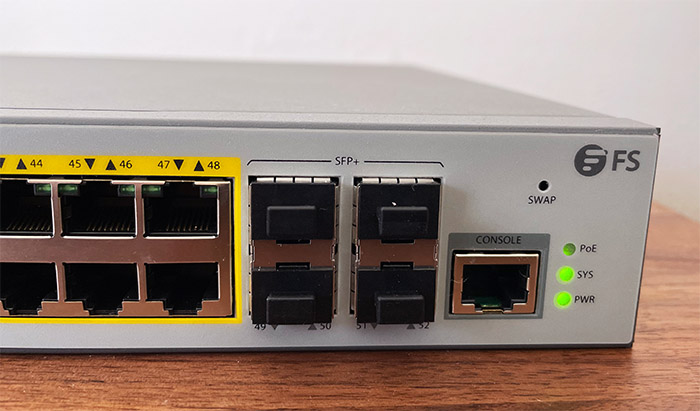
Lastly, there is a Console port (you do get an RJ45 to VGA cable in the package) and a recessed SWAP button. It took me a while to figure out what these buttons actually does, but it actually has a very simple function. Remember the single LED for each port? Well, if you don’t want to see if there is data transfer happening at that specific port level, then press the SWAP button to see the PoE status of the ports.
Internal Hardware (FS S3400-48T4SP Teardown)
Just like with every other FS network switch, be aware that there is a warranty seal which, when broken (and it will if you’re trying to remove it), then the warranty will be voided. If that’s alright with you (I am not that much of a fan of this approach and prefer to be able to repair our own devices), then remove the seven screws and then carefully slide out the top cover. Having a peek inside, I admit I was a bit overwhelmed since so much is going on.
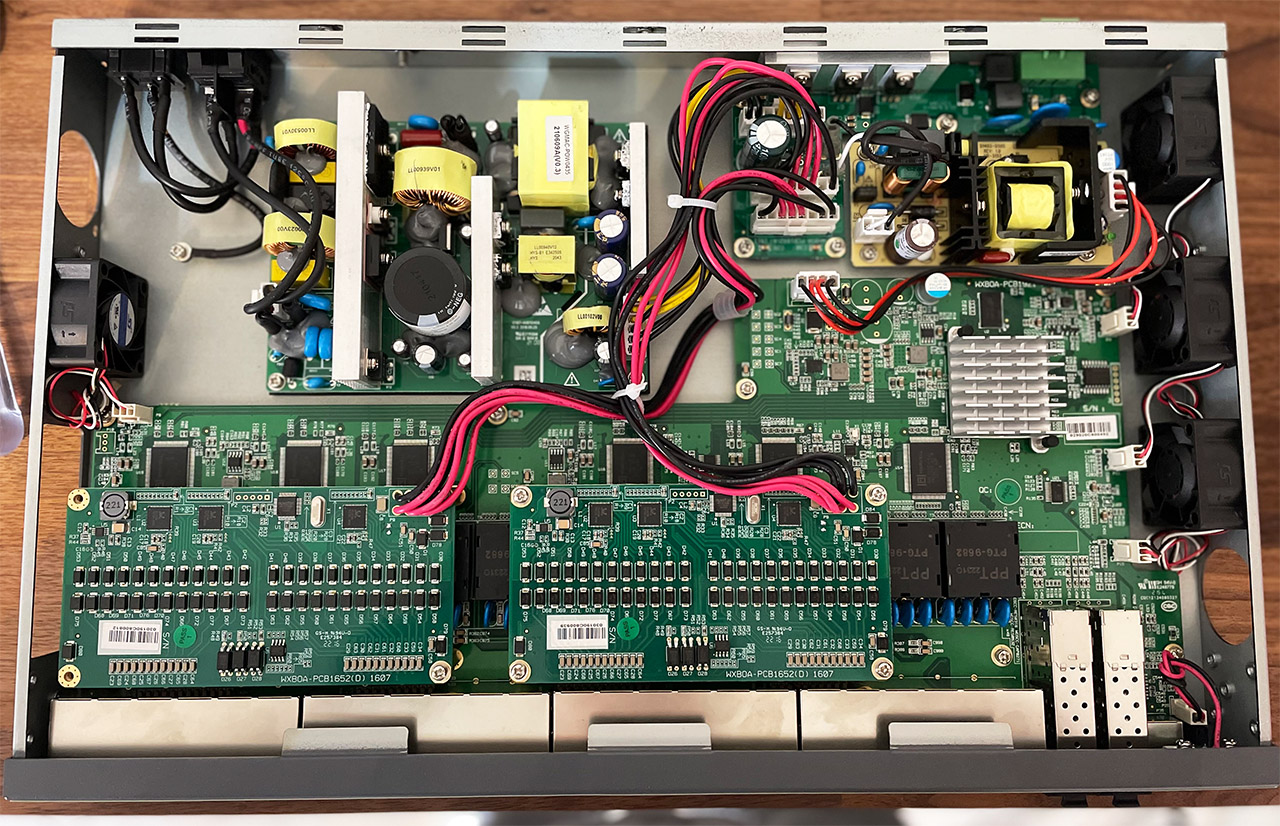
I quickly saw the two types of power supplies and, for anyone that was curious why some devices have a DC power supply, just look at the difference in size between DC and AC PSUs inside the case of the FS S3400-48T4SP. And it’s also interesting to see the two smaller PCBs on top of the ports, each with its own Nuvoton M0516LDN high-precision internal oscillator, as well as three Realtek RTL8238B transceivers (two sets on each smaller PCB).
After removing the two smaller PCBs, I could see the six Marvell 88E1680-LKJ2 highly integrated PHY controllers (10/100/1,000Mbps) and also on the bigger board, there were 16MB of NOR flash memory from Winbond (25Q128JVFQ) and 256MB of RAM from Micron (IYKI5 D9PTK). The last component that I was curious about was the main chip which had a heatsink on top and, after turning the PCB upside down and releasing the two spring pins (no thermal paste glue), I could see that it was a Microchip Technology VSC7448YIH-02 SparX™-IV-80 (500 MHz MIPS-24KEc CPU).
| FS S3400-48T4SP | FS S3150-8T2FP | FS S2800-8T | FS S3150-8T2FP | FS S3410-10TF-P | FS S3910-24TF | |
| Switch Chipset | VSC7448YIH-02 SparX™-IV-80 | Broadcom BCM56150A0KFSBLG | Realtek RTL8380M | MIPS32 4KEc CPU | Broadcom BCM53343A0KFSBG | Broadcom BCM56152A0KFSBLG |
| RAM | 256MB Micron IYKI5 D9PTK | 512MB Micron ICP45 D9SHD | 128MB Winbond W631GG8NB-12 | 128MB Winbond W631GG8NB-12 | 256MB SKhynix H5TC4G63EFR | 512MB Micron 0ZP45 D9SHD |
| Storage | 16MB Winbond 25Q128JVFQ | 256MB WP 29F2G08ABAEA | 16MB Winbond 25Q128JVSQ | 16MB Winbond 24Q128JVSQ | 256MB Micron 29F2G08ABAEA | 256MB NAND Micron 29F2G08ABAEA |
Note: The FS S3400-48T4SP features a forwarding rate of 132Mpps, a switching capacity of 176Gbps, 32K MAC addresses and a packet buffer of 4MB.
Setup and Features
The installation process is very similar to what I had to do with other FS network switches. Well, it’s actually the same: the device comes with a static IP which is 192.168.1.1, so it will not receive an IP address from the router / gateway which means that you will have to change it manually. If you’re using a Windows OS computer, then the process is straight-forward. Set a static IP address on the computer so that it matches the subnet of the FS S3400-48T4SP – in my case, the subnet was 192.168.50.x, so I switched it to 192.168.1.2.
I could then quickly access the FS GUI using the admin / admin credentials for the username and password. Then, I navigated to L3 Config from the menu, and I clicked on VLAN Interface and IP Addresses. Here, I simply changed the IP Attribute from Manual Config to DHCP Auto Config.

It’s also a wise move to change the default admin account. This can be done by navigating to System Management > User Management, creating a new admin account and then Batch deleting the old admin account. These are the most basic changes that every user needs to do, so let’s explore the graphical interface a bit more.
The GUI
There are several layouts that FS uses for its various switch series and the one that’s used by the FS S3400-48T4SP is the same as on the FS S3150-8T2FP. So, expect a vertical menu on the left side which, even if at first glance seems simple, it’s going to open up a lot of options. So yes, the amount of configuration that you can do at the switch level is very high. The first tab is the Device status that, as expected, shows data and info status about various functions of the network switch (includes Interface State and Flow, MAC address table, as well as Optic Module Info, if you decide to make use of the SFP slots) and then we get the Basic Config.
And it’s actually very basic allowing you to change the Hostname and time. The next section, the Port Config paints a better picture about what to expect from the web-based GUI since you get to configure the speed, status, mode, flow control and more for each Ethernet and SFP port.
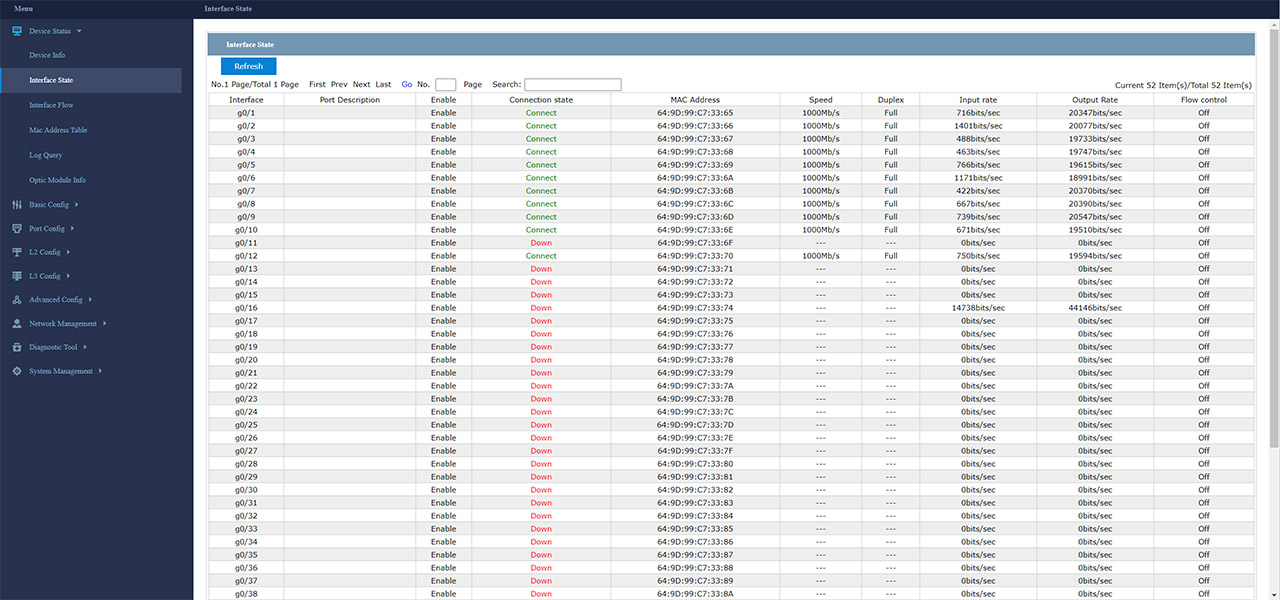
You can set the Rate Limit, configure the Port Mirroring, enable the KeepAlive Detection on individual ports, as well as enable various filters globally (such as ICMP, IGMP and more). There’s also Loopback detection, Storm Control and it’s possible to set Static MAC Binding and Filtration. The L2 Config is very comprehensive, allowing the user to configure the VLANs, STP, IGMP, GVRP, LLDP and DDM (and a lot more); but it’s worth mentioning the support for port aggregation, as well as the Ring and Multiple Ring Protection.
The L3 Config goes a step further and it allows you to enable a DHCP Server, add Static Routes and configure the OSPF process, all being in line with other ‘mild’ managed switches on the market – if you need more than that, there are some L3+ network switches available from FS. I mentioned a Basic Config section and there seems to be an Advanced Config tab as well. Here, the admin can prioritize the ports (QoS), create an IP ACL list, a MAC list and set up the HTTPS configuration.

There is also the Network Management section where you can set up the SNMP management and configure the RMON, but the Diagnostic Tool is just Ping, which is very basic. Lastly, there’s the System Management where you can upgrade the firmware, check the logs and configure the user access.
The Performance
FS usually presents the results that they got after testing their network switches using the ixia XGS12 hardware and this is also the case with the FS S3400-48T4SP which showed promising results after running the IxNetwork tests (RFC2544) for more than half an hour. These tests check the latency and the throughput of the Ethernet switch and, as much as I would love to check them myself, the type of equipment necessary to do so easily gets close to 10K (which is incredibly far from my actual budget), so yes, what FS has to offer will do nicely.
The results are available on the official website, so you can check them there, but know that the average aggregated latency is a bit over 0.04ms, which is negligible. And the aggregated frame loss when the frame size was between 64KB and up to 1,518KB was zero, which, again, is an excellent value. The tests also revealed that the average latency per frame size (1 – 64KB up to 1 – 1,518KB) was underneath 0.01ns).
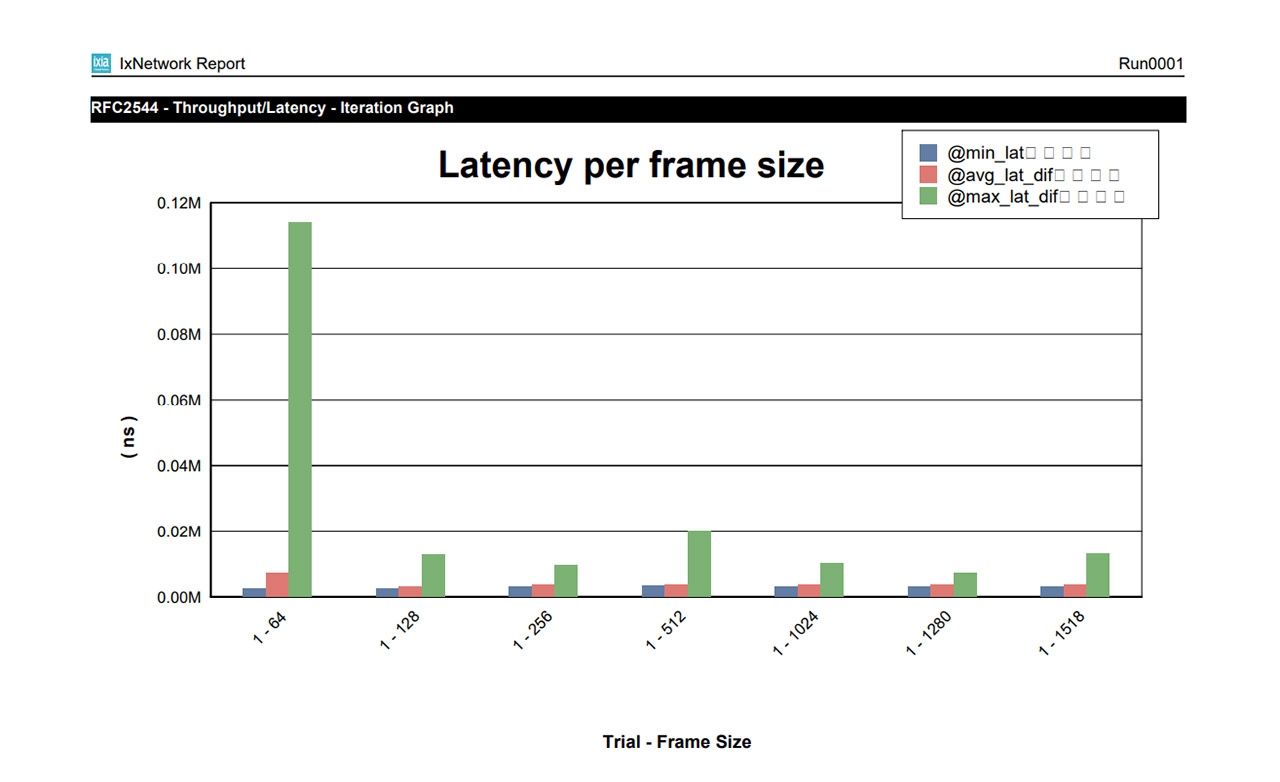
I was able to run a few tests of my own, such as the LAN-to-LAN throughput test and upstream, I saw an average of 940Mbps, while downstream, I measured an average of 866Mbps. Next, I decided to connect as many access points as I could to see when the maximum threshold would be reached.
I attached 13 PoE WiFi access points, and all would receive power, but this is only in idle mode, because as soon as all APs would connect clients, the power consumption would go up. For example, the WAX650S is one of the more power-hungry devices and it needs about 31W. Considering that the maximum that the FS S3400-48T4SP can deliver is 370W, then even at a higher load, you would still be able to easily go above 10 high-end PoE+ WiFi 6 access points.
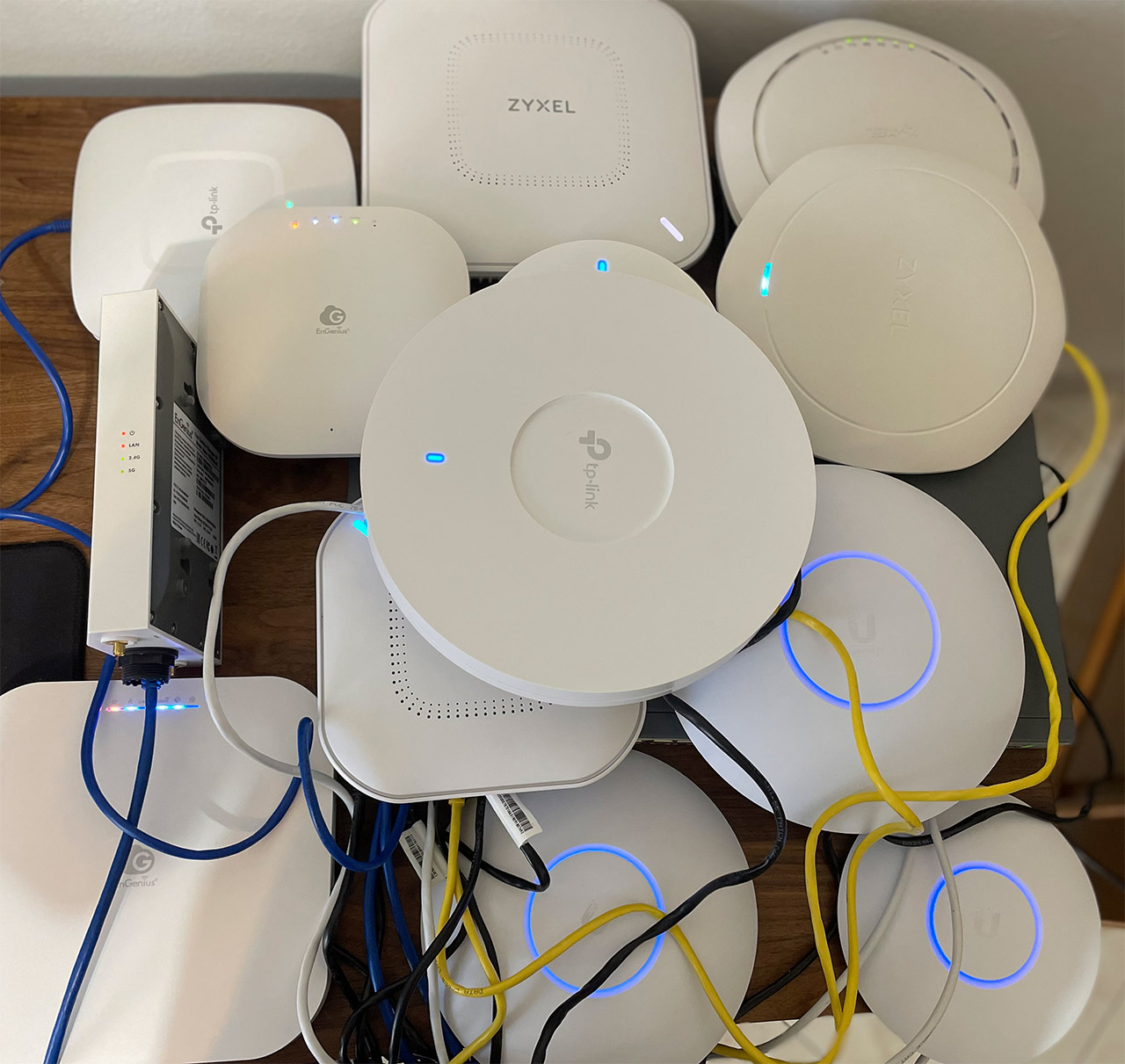
The Conclusion
As every other 48-port network switch, its sole purpose is to handle a very large network and the FS S3400-48T4SP seems to be built to be up for the task. The case has proper ventilation (although the fans are very loud) and you can mount the device into a rack. There is support for PoE with a budget up to 370W and, if it’s not enough, you can get a slightly pricier model from FS. The software, as before, is simple, yet very comprehensive and I am sure a lot of system admins that are familiar with Cisco hardware will enjoy the FS S3400-48T4SP as well. Obviously, the cost is substantially less than its main competitors, but FS has proven to be reliable long-term, so if you don’t have a big budget, then FS can provide some relief and get your business going.

Mark is a graduate in Computer Science, having gathered valuable experience over the years working in IT as a programmer. Mark is also the main tech writer for MBReviews.com, covering not only his passion, the networking devices, but also other cool electronic gadgets that you may find useful for your every day life.

